Preservation of the Berlin Wall
Maarten Vanden Eynde
Preservation of the Berlin Wall, 2007
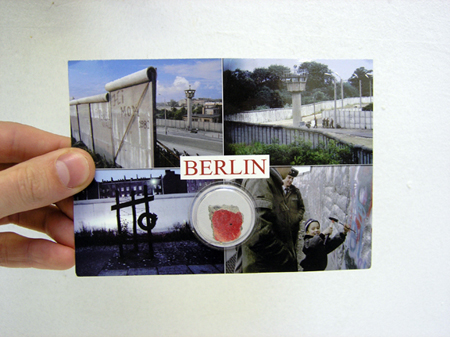
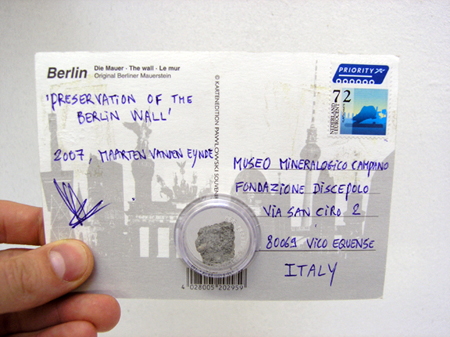
The Berlin Wall, known in the Soviet Union and in the German Democratic Republic as the “Anti-Fascist Protective Rampart,” was a separation barrier between West Berlin and East Germany, which closed the border between East and West Berlin for 28 years. Construction on the Berlin Wall began on August 13, 1961, and it was dismantled in the weeks following November 9, 1989. The Wall was over 155 km (96 miles) long. A no man’s land was created between the barriers, which became widely known as the “death strip”. It was paved with raked gravel, making it easy to spot footprints left by escapees; it offered no cover; it was booby-trapped with tripwires; and, most importantly, it offered a clear field of fire to the watching guards.
Over the years, the Wall went through four distinct phases:
1. Basic wire fence (1961)
2. Improved wire fence (1962-1965)
3. Concrete wall (1965-1975)
4. Grenzmauer 75 (Border Wall 75) (1975-1989)
The “fourth generation wall”, known officially as “Stützwandelement UL 12.11″(Retaining wall element UL 12.11), was the final and most sophisticated version of the Wall. Begun in 1975 and completed about 1980, it was constructed from 45,000 separate sections of reinforced concrete, each 3.6 m high and 1.2 m wide, and cost 16,155,000 East German Marks. The top of the wall was lined with a smooth pipe, intended to make it more difficult for escapers to scale it. It was reinforced by mesh fencing, signal fencing, anti-vehicle trenches, barbed wire, over 116 watchtowers, and twenty bunkers. This version of the Wall is the one most commonly seen in photographs, and surviving fragments of Wall in Berlin and elsewhere around the world are generally pieces of the fourth-generation Wall.
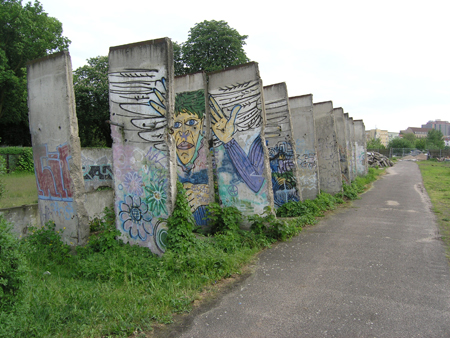
Maarten Vanden Eynde, Berlin Wall, 2006
‘For the exhibition Turn to Stone in the Museo Mineralogico Campano I send a postcard to the museum containing a small plastic box with a piece of the Berlin Wall. I donated the work to the director with the specific question to preserve the Berlin Wall by adopting the piece in the permanent collection. He agreed and from now on the postcard stands in the display surrounded by other mineral stones.
The small stone contains the story of the whole wall and preserves an important part of human history. It represents World War II, the cold war, communisms and all the personal stories that are connected to the Berlin Wall. It’s a memory of the past for the future.’
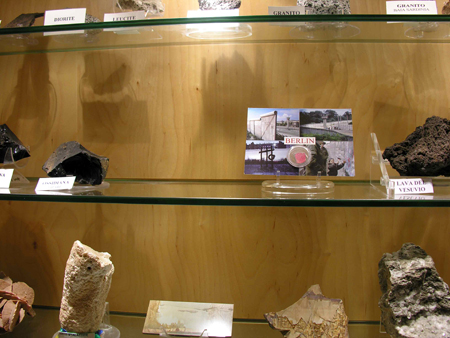
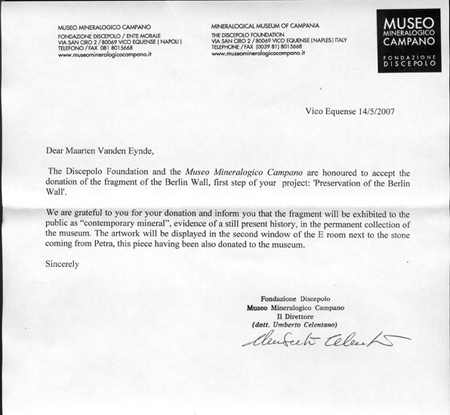
november 15th, 2007 at 00:50
hello
i fell upon your website while doing some research for my thesis project based on a site situated behind the former Berlin Wall border. i saw that above picture that you took of the remnant pieces placed parallel to each other… i was wondering if you knew why they are placed in their specific positions or are they just organized for storage on the site?
juni 13th, 2008 at 15:36
Hi Jo
I am an artist doing a work on the Berlin Wall. I visited the site shown in the picture May 2007. It is at the northern side of the Denkmal Berliner Mauer in the Bernauer Strasse. The concrete elements are piled up in the Sophienfriedhof with other materials from the cemetery. They are part of the Border Wall 75 along the Bernauer Strasse, as the ones used to build the memorial. I assume that they will be removed as soon as the construction works in the area are complete. You can easily find the location on this map next to
http://www.berlin.de/mauer/mauerweg/index/index.de.php
Good Luck with your research
Paolo
maart 3rd, 2009 at 16:05
Hey, nice post, I also got sent one of those great postcards with a piece of “wall” – excellent.
maart 22nd, 2009 at 00:07
I was looking for a picture that I saw when I was in Berlin of East German border guards in Sophienfriedhof cemetery. Do you know where I can find a copy?